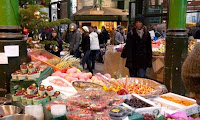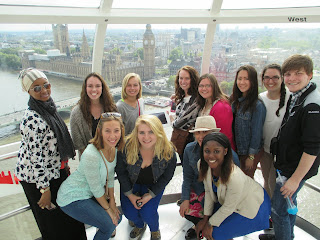Today, being our last day of exploring London, we wanted to make sure we made the most out of it. We visited The Tower of London, The Tower Bridge, The Globe Theatre, The London Eye, and a two of the members in the class even went to the Tate Modern.
Her Majesty's Royal Palace and Fortress, known as the Tower of London, is a historic castle located on the north bank of the River Thames in central London.
It was founded towards the end of 1066 as part of the Norman Conquest of England. As a whole, the Tower is a complex of several buildings set within two concentric rings of defensive walls and a moat.
The peak period of the castle's use as a prison was the 16th and 17th centuries, when many figures who had fallen into disgrace, such as Elizabeth I before she became queen, were held within its walls. Today the Tower of London is one of the country's most popular tourist attractions. Under the ceremonial charge of the Constable of the Tower, it is cared for by the charity Historic Royal Palaces and is protected as a World Heritage Site.
Once inside the "Bloody Tower," we were able to see different methods of torture used in the Tower of London. To the left is "the rack," London's most infamous instrument of torture. Hands and feet were tied down and stretched to the limit with iron teeth ensuring that the victim couldn't move.
Here is also where the Crown Jewels are held and protected. The Crown Jewels, part of the Royal Collection, are the most powerful symbols of the British Monarchy and hold deep religious and cultural significance in our nation’s history. The Crown Jewels at the Tower of London are a unique working collection of royal regalia and are still regularly used by The Queen in important national ceremonies, such as the State Opening of Parliament.
Also within the grounds of the Tower of London, held in the White Tower, lies the Royal Armory. This tower marks the central keep of the Tower of London. The Royal Armouries is Britain’s national museum of arms and armour, and one of the most important museums of its type in the world. Its origins lie in the Middle Ages, and at its core is the celebrated collection originating. The collection of about 75,000 items are now displayed.

As a surprise to us all, as we were crossing the Tower Bridge, the gates went up and a ship passed underneath. This was unexpected but certainly a once in a lifetime experience!
Borough Market is London’s most renowned food market; a source of exceptional British and international produce. But it’s not just the sheer quality of the food on offer that makes Borough Market special, it is also about the people, the place, and the overall experience.
Shakespeare's Globe is a reconstruction of the Globe Theatre, an Elizabethan playhouse in the London Borough of Southwark, on the south bank of the River Thames that was originally built in 1599, destroyed by fire in 1613, rebuilt in 1614, and then demolished in 1644.
The modern reconstruction is an academic approximation based on available evidence of the 1599 and 1614 buildings. It was founded by the actor and director Sam Wanamaker, built about 750 feet from the site of the original theatre and opened to the public in 1997.The original Globe Theatre was built in 1599 by the playing company, Lord Chamberlain's Men, to which Shakespeare belonged, and was destroyed by fire on 29 June 1613. The fire was caused by an accident with a cannon during a production of Henry VIII.
Here you can see Julia, an English major, enjoying her experience in The Globe Theater.
The London Eye took 7 years to construct and was designed by a number of architects including, Mark Sparrowhawk, David Marks and Julia Barfield.
More than 3 and a half million people every year go on the London Eye.
The capsules are air-conditioned and seats are provided, although passengers are able to walk around.
Below you will find a list of facts about the London Eye:
1. The London Eye is not a Ferris wheel. It’s the world’s tallest cantilevered observation wheel2. Supermodel Kate Moss has been on the London Eye 25 times – the record for a UK celebrity
3. On average the London Eye receives more visitors per year than the Taj Mahal and the Great Pyramids of Giza
4. You can see up to 40 kilometres in all directions (that’s as far as Windsor Castle on a clear day)
5. In December 2005 the London Eye was lit pink in celebration of the first Civil Partnership performed on the wheel
6. The 32 capsules on the London Eye are representative of the 32 London boroughs, and each one weighs as much as 10 tons.
7. Despite there only being 32 capsules, for superstitious reasons they are numbered 1 – 33. For good luck number 13 is left out!
8. The London Eye can carry 800 people each rotation, which is comparable to 11 London red double decker buses
9. The London Eye was not the original name, first it was called the Millennium Wheel.
10. Capsules travel at a leisurely pace of 26cm per second, which is twice as fast as a tortoise sprinting.
 From the top of the London Eye you can see things about 25 miles away. On a clear day, you can make out Windsor Castle. It is one of the highest viewing platforms in London (the viewing platform of the Shard is higher).
From the top of the London Eye you can see things about 25 miles away. On a clear day, you can make out Windsor Castle. It is one of the highest viewing platforms in London (the viewing platform of the Shard is higher).It takes 30 minutes to complete a revolution and doesn’t have to stop for passengers to step on and off.
Fun Fact: The London Eye is not the first big wheel to be located in London. The Great Wheel was constructed in 1895 for the Empire of India Exhibition. It was demolished in 1907 having being used by over 2 million people.

Elizabeth and Michaela visited the Tate Modern on their free time today. In the picture to the right, Michaela is seen using the drawing bar where her drawing was posted instantly as a part of a virtual mosaic.



















No comments:
Post a Comment